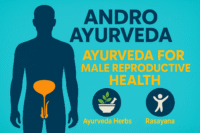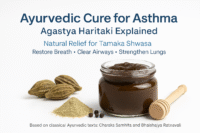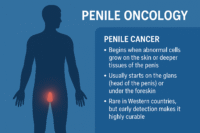- Shatavari – The Queen of Women’s Health
- Shatavari – The Queen of Women’s Health
- Yashtimadhu – The Hormone Harmonizer
- Yashtimadhu – The Hormone Harmonizer
- Clinical Research and Pharmacological Evidence
- Cosmetic and Nutraceutical Applications
- Fenugreek – The Volume Builder
- Synergy of the Trio
- Integrative Guidance for Complete Feminine Contouring
- Related Reading
- Prakriti-Specific Personalization
- Vata Prakriti – Nourish and Build
- Pitta Prakriti – Calm and Balance
- Kapha Prakriti – Tone and Firm
- Why This Matters
- ⚕️ Educational Highlight: Why Generic Products Fail
- Holistic Benefits Beyond Enlargement
- Frequently Asked Questions (FAQs)
- References
Natural Breast Enlargement with Ayurveda is more than just an aesthetic choice — it’s a journey toward feminine confidence, hormonal balance, and inner vitality. In today’s world, women are often drawn to quick-fix options such as implants, fat transfers, or hormone-based creams. While these may deliver visible results, they come with potential side effects, health risks, and results that rarely last.
Ayurveda offers a safer, holistic alternative. According to this ancient science, fuller and well-shaped breasts reflect the nourishment of Rasa Dhatu (plasma), Stanya Dhatu (breast tissue), and the radiance of Ojas (vital energy). When these Dhatus are healthy and balanced, the body naturally develops harmonious curves and stable hormonal strength.
Instead of forcing artificial changes, Ayurveda focuses on rejuvenation and nourishment from within, using time-tested herbs that strengthen and revitalize the body’s own tissues. Among these, three stand out for their proven efficacy and safety — Shatavari, Yashtimadhu, and Fenugreek. Together, they nourish the reproductive system, balance hormones, and promote gradual, natural development — leading to confidence that feels as authentic as it looks.
Shatavari – The Queen of Women’s Health
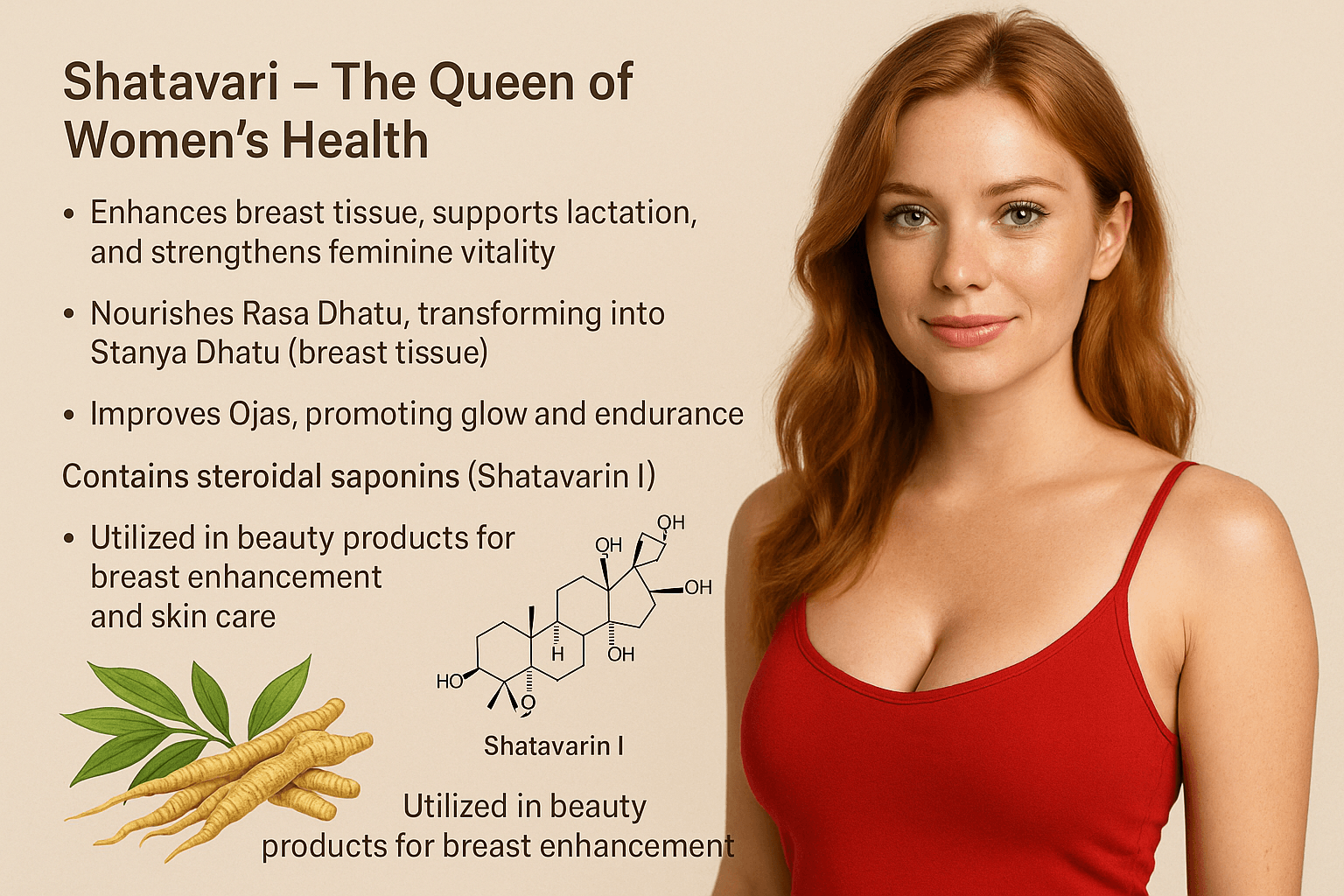
Shatavari – The Queen of Women’s Health
The Feminine Elixir of Ayurveda
Among the thousands of herbs in Ayurveda, Shatavari (Asparagus racemosus) holds a special status as the ultimate women’s tonic. Its very name means “she who possesses a hundred husbands,” a poetic metaphor for boundless vitality and reproductive strength.
Unlike synthetic hormonal pills or cosmetic creams, Shatavari does not force temporary change — it works from the inside out, nourishing the Rasa Dhatu (plasma) and Stanya Dhatu (breast tissue) to promote natural, sustained development.
Ayurveda views well-developed, firm, and proportionate breasts not as symbols of vanity but as indicators of balance, health, and reproductive vigor. When these tissues are properly nourished, they reflect equilibrium in the hormonal and emotional systems of a woman’s body.
Classical Ayurvedic Foundation
Shatavari’s traditional description is found in the Bhavaprakasha Samhita (Madhyama Khanda, 38/47):
स्तन्यजनना शतावरी बल्या बृंहणा गुरुः। शीतला वृष्या वातपित्तकफहरा हिताऽग्निदा॥
Stanyajanana shatavari balya brimhana guruḥ, sheetala vrishya vata-pitta-kaphahara hita-agnida.
Translation: “Shatavari enhances breast milk and nourishes breast tissue, strengthens the body, builds vitality, is cooling in nature, supports fertility, balances all three doshas, and improves digestive strength.” [1]
This single verse summarizes the multidimensional action of Shatavari. It strengthens Rasa Dhatu, which nourishes Stanya Dhatu (breast tissue), thereby supporting natural fullness and lactation. Its Vrishya (aphrodisiac) and Brihmana (nourishing) properties enhance both physical and emotional femininity.
Ayurvedic Mechanism of Action
According to Ayurvedic physiology, the seven Dhatus (tissues) represent the stages of nourishment in the body. Shatavari primarily acts on:
- Rasa Dhatu (plasma and lymph): Improves nutrient flow and hydration, directly influencing breast tissue formation [1][2].
- Stanya Dhatu (breast tissue): Supports tissue proliferation and elasticity, promoting balanced fullness [2].
- Shukra Dhatu (reproductive tissue): Restores hormonal rhythm, fertility, and libido [2].
- Ojas (vital essence): Enhances immunity, emotional stability, and skin radiance [3].
By working across these layers, Shatavari delivers a complete rejuvenative effect strengthening digestion (Agni), calming the mind (Satva), and balancing all three doshas, especially Vata and Pitta.
Chemical Constituents and Their Role
Modern phytochemical analysis reveals that Shatavari contains steroidal saponins, collectively known as Shatavarins, along with alkaloids, flavonoids, and polyphenols [4].
The most pharmacologically significant is Shatavarin IV (C₄₅H₇₂O₁₆), which has been identified as a natural phytoestrogen a plant compound capable of mimicking estrogenic activity in a gentle, balanced manner [5].
Mechanism of Shatavarin IV
- Binds to estrogen receptors (ER-α and ER-β): Regulates hormonal activity without overstimulation.
- Stimulates mammary epithelial growth: Supports breast tissue nourishment and firmness.
- Promotes prolactin secretion: Enhances lactation and glandular development.
- Improves reproductive organ tone: Strengthens uterine muscles and endometrial health.
Unlike synthetic estrogens that disrupt hormonal feedback loops, phytoestrogens like Shatavarin IV act as adaptogens enhancing hormone levels when low and moderating them when excessive [5][6].
Clinical Evidence and Scientific Validation
Several studies validate Shatavari’s role in women’s reproductive and hormonal health:
- A randomized controlled trial in lactating mothers found significant improvement in breast milk production and infant weight gain after Shatavari supplementation compared to placebo [7].
- A clinical overview published in the Journal of Ayurveda and Integrative Medicine highlights improved ovulation regularity, endometrial thickness, and menstrual stability in women using Shatavari formulations [8].
- Animal and in-vitro studies demonstrate its antioxidant, anti-inflammatory, and adaptogenic effects on ovarian and mammary tissues [4][6].
These findings confirm what Ayurvedic seers described millennia ago: that Shatavari nourishes not only the external appearance but also the inner hormonal ecosystem.
Cosmetic and Nutraceutical Applications
As the global demand for natural hormonal balance products increases, Shatavari has found a prominent place in the cosmetic and nutraceutical industry. Its extracts, standardized for Shatavarins, are now included in:
- Breast-firming and toning creams: Biotique Bio Bust Firming Cream, Nature’s Essence Bust Uplift Lotion [9].
- Women’s hormonal supplements: Himalaya Evecare, Dabur Shatavari Tablets, Organic India Shatavari [10][11][12].
- Skin-rejuvenating products: Blended with saffron and aloe vera for its natural estrogenic and collagen-promoting effects [13].
This integration of Ayurveda with modern cosmeceutics allows women to experience the rejuvenative benefits of Shatavari without relying on synthetic hormones.
Dietary and Therapeutic Integration
For holistic breast and hormonal health, Shatavari is often administered as:
- Shatavaryadi Avaleha: A classical herbal jam combining Shatavari with Ghee, Mishri, and Yashtimadhu for tissue nourishment and hormonal balance [14].
- Shatavari Kalpa: A granulated preparation used in lactating mothers to improve breast milk and stamina.
- Capsules or extracts: Standardized formulations (250–500 mg twice daily) used in women with hormonal irregularities.
It is best taken with milk or ghee as an Anupana (vehicle) to improve bioavailability and Dhatu penetration.
Safety Profile and Contraindications
Shatavari is one of the safest herbs known to Ayurveda, suitable for long-term use under professional supervision. However:
- Pregnant women should consult an Ayurvedic doctor for proper dosage.
- Kapha-dominant individuals may need digestive herbs alongside to prevent sluggishness.
- Always ensure herbs are GMP-certified and standardized for purity and potency [15].
Why Shatavari Stands Apart
Shatavari is not merely a “breast enlargement herb.” It is a complete Rasayana that aligns physical beauty with inner vitality. By balancing hormones, improving emotional well-being, and restoring reproductive strength, it helps women achieve holistic femininity — radiant both inside and out.
Where modern medicine focuses on external modification, Shatavari’s wisdom lies in transforming the terrain of the body — achieving lasting beauty through internal harmony.
Yashtimadhu – The Hormone Harmonizer
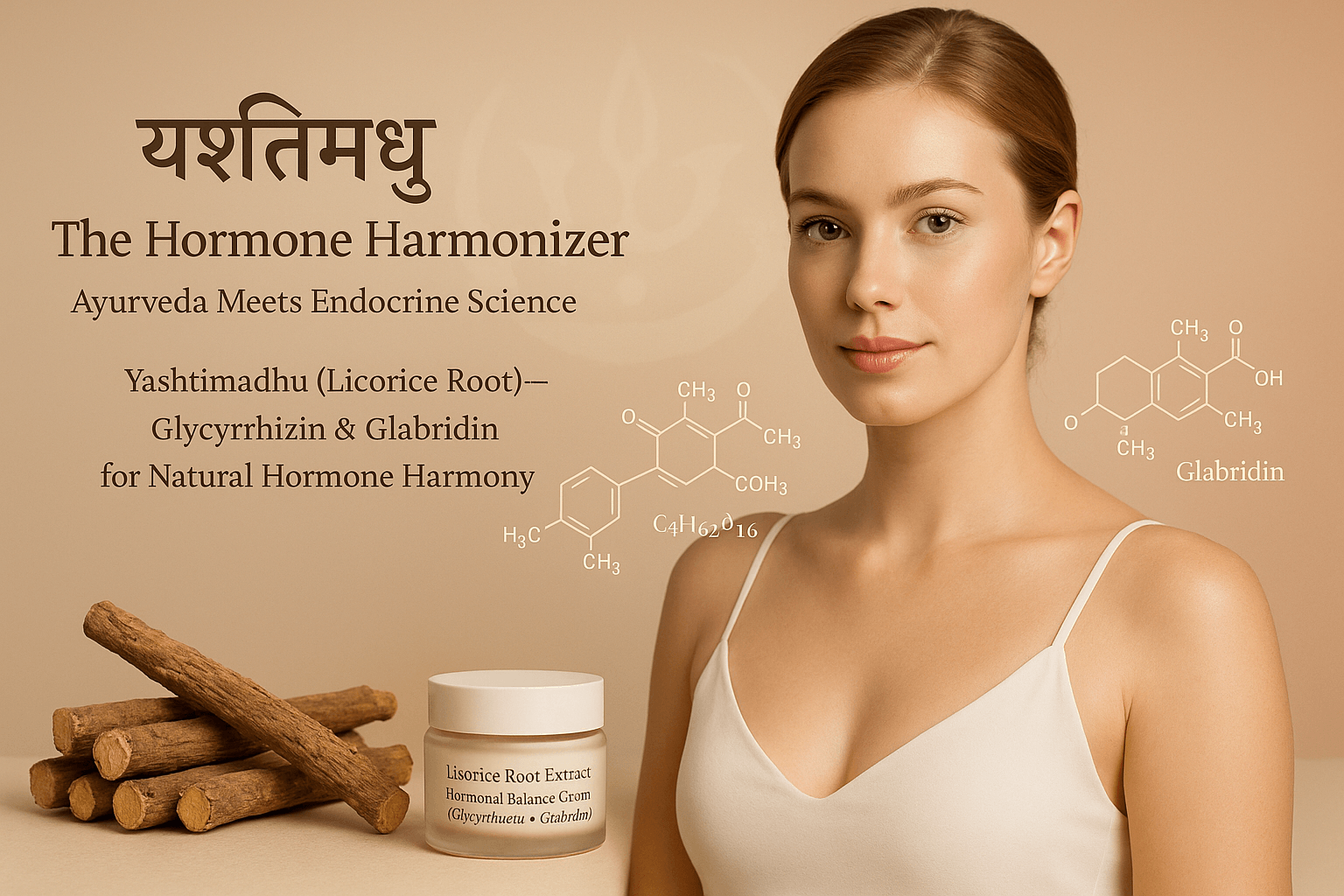
Yashtimadhu – The Hormone Harmonizer
The Sweet Root of Inner Balance
In Ayurveda, Yashtimadhu (Glycyrrhiza glabra, commonly known as Licorice Root) is celebrated as one of the most sattvic and rejuvenating herbs for women. Its sweet taste (Madhura Rasa) and cooling potency (Sheeta Virya) calm the mind, nourish the body, and bring harmony to fluctuating hormones.
While modern science recognizes its anti-inflammatory and adaptogenic properties, Ayurveda sees it as a balancing Rasayana that stabilizes internal rhythms — especially for women prone to stress-induced hormonal imbalance or sagging breast tissue.
Yashtimadhu is often called the “Hormone Harmonizer” because it bridges emotional and physical balance. Where synthetic hormone therapies offer short-term correction, Yashtimadhu restores equilibrium by nourishing Dhatus (body tissues) and calming Agni (the metabolic fire).
Classical Ayurvedic Foundation
Yashtimadhu’s revered status is detailed in Bhavaprakasha Nighantu (Haritakyadi Varga, verse 191–193):
मधुरः शीतलः स्निग्धो यष्टिमधु रसायणम्।
कण्ठ्यं च वृष्यं वण्श्यं च शोधनं मेध्यमेव च॥
Madhuraḥ śītalaḥ snigdho yaṣṭimadhu rasāyanam, kaṇṭhyaṃ ca vṛṣyaṃ vaṇśyaṃ ca śodhanaṃ medhyameva ca.
Translation: “Sweet, cooling, and unctuous, Yashtimadhu is a Rasayana that strengthens vitality, enhances fertility, purifies the system, supports mental clarity, and rejuvenates tissues.” [16]
From an Ayurvedic perspective, Yashtimadhu nourishes Rasa Dhatu (plasma) and Mamsa Dhatu (muscle tissue), helping maintain elasticity and firmness of the breast area.
Its Snigdha (unctuous) and Madhura (sweet) properties counteract tissue dryness and degeneration — a key factor in breast sagging and hormonal decline [17].
Ayurvedic Mechanism of Action
In Ayurvedic physiology, beauty and hormonal harmony arise from the nourishment of Rasa and Shukra Dhatus. Yashtimadhu supports these through its multi-dimensional effects:
- Balances Pitta Dosha: Cooling nature reduces inflammation and excess heat affecting breast tissue and hormonal glands [18].
- Replenishes Rasa Dhatu: Improves tissue hydration and nutrient flow, essential for firmness and fullness [19].
- Supports Shukra Dhatu (Reproductive Health): Enhances hormonal balance and fertility, particularly in Pitta-dominant women [20].
- Enhances Ojas: Promotes emotional calmness, vitality, and radiant glow — the ultimate markers of internal balance [21].
Unlike quick-fix hormonal drugs, Yashtimadhu gradually retrains the body to produce and regulate hormones efficiently, which is why it’s often combined with Shatavari and Fenugreek in traditional Stanya–Sphika Vardhani Rasayana formulations.
Chemical Constituents and Their Roles
Modern pharmacology identifies two primary active compounds in Yashtimadhu that explain its hormonal effects:
- Glycyrrhizin (C₄₂H₆₂O₁₆): A triterpenoid saponin responsible for estrogenic and anti-androgenic actions. It inhibits 11β-hydroxysteroid dehydrogenase, leading to improved estrogen-progesterone ratios and glandular stability [22].
- Glabridin (C₂₀H₂₀O₄): A flavonoid phytoestrogen that binds to estrogen receptors, promotes collagen synthesis, and improves skin and tissue elasticity [23].
Mechanism Overview
- Endocrine Modulation: Glycyrrhizin modulates cortisol metabolism, preventing hormonal fatigue and supporting reproductive gland function [22][24].
- Tissue Regeneration: Glabridin stimulates fibroblast activity, improving firmness and reducing oxidative damage [25].
- Phytoestrogenic Action: Both compounds gently mimic estrogen, promoting healthy breast volume and skin tone [26].
Unlike synthetic estrogens, Yashtimadhu’s natural compounds adapt to the body’s needs, avoiding the risks of hormonal overload.
Clinical Research and Pharmacological Evidence
Scientific studies strongly validate the Ayurvedic claims about Yashtimadhu:
- Endocrine Balance: Research from the Journal of Steroid Biochemistry and Molecular Biology confirms Glycyrrhizin’s role in modulating estrogen and prolactin levels, improving female hormonal function without toxicity [27].
- Tissue Firmness: Studies show that Glabridin enhances collagen synthesis in human dermal fibroblasts, which explains its use in skin-firming and breast-toning formulations [28].
- Antioxidant Protection: A comparative study published in Phytomedicine demonstrates Yashtimadhu’s potent antioxidant profile, protecting mammary cells from oxidative stress — a major factor in sagging and aging [29].
- Menopausal Support: Clinical trials highlight improved emotional balance, vaginal lubrication, and overall vitality in perimenopausal women taking licorice extract supplements [30].
These studies demonstrate how Yashtimadhu offers a scientific bridge between Ayurvedic Rasayana therapy and modern endocrine pharmacology.
Cosmetic and Nutraceutical Applications
Yashtimadhu has become a premium ingredient in the global beauty and nutraceutical industries for its skin-brightening, firming, and hormone-stabilizing actions. It’s widely used in:
- Licorice Root Extract Creams: Kiehl’s Clearly Corrective™ Brightening Cream, Forest Essentials Soundarya Radiance Cream — for tone, firmness, and hormonal balance [31].
- Breast and Skin Firming Serums: Mamaearth Breast Firming Oil and WOW Skin Science Firming Cream — leveraging Glabridin’s collagen-boosting effects [32].
- Hormonal Balance Supplements: NOW Foods Licorice Root Capsules, Planet Ayurveda Yashtimadhu — used in managing PMS, menopausal imbalance, and adrenal fatigue [33].
Its dual action — as a cosmeceutical agent and endocrine adaptogen — makes Yashtimadhu one of the most versatile herbs for women’s wellness.
Ayurvedic Formulations and Dosage
In Ayurvedic medicine, Yashtimadhu is used in multiple classical formulations that enhance both inner and outer beauty:
- Yashtimadhu Churna: Fine powder (2–3 g) with milk twice daily to promote hormonal and tissue balance [34].
- Shatavaryadi Avaleha: A combination of Yashtimadhu, Shatavari, and Ghee for nourishing Rasa and Stanya Dhatus.
- Vyadhiharan Rasayana: A fortified Rasayana that includes Yashtimadhu for systemic rejuvenation and stress regulation.
Taken under professional supervision, it acts holistically — rejuvenating tissues, harmonizing hormones, and improving emotional health.
Safety, Precautions, and Professional Advice
While Yashtimadhu is generally safe, prolonged or unsupervised use can cause sodium retention or mild hypertension in sensitive individuals due to its glycyrrhizin content [35].
Hence:
- Avoid in uncontrolled hypertension or kidney disorders.
- Always use standardized extracts (≤2% glycyrrhizin) from GMP-certified sources.
- Combine with herbs like Shatavari or Amalaki to balance effects for long-term Rasayana therapy.
Under guided usage, Yashtimadhu remains one of the safest and most harmonizing tonics for women.
Why Yashtimadhu Deserves Global Recognition
Yashtimadhu represents Ayurveda’s brilliance — harmonizing internal chemistry without synthetic interference. It strengthens tissues, balances hormones, and enhances radiance naturally.
Modern medicine isolates hormones; Ayurveda restores harmony among them.
In this lies the timeless truth — true beauty is not manufactured; it is nourished.
Fenugreek – The Volume Builder

Nature’s Secret for Feminine Fullness
Fenugreek (Trigonella foenum-graecum), known as Methi in Ayurveda, has been used for centuries not only as a culinary spice but also as a powerful tonic for women’s vitality. It is warm, nourishing, and deeply rejuvenating — working at the root of underdeveloped breast tissue by enhancing circulation, hormonal balance, and nutrient absorption.
Where Shatavari refines and Yashtimadhu harmonizes, Fenugreek builds. It provides the foundation of Mamsa Dhatu (muscle tissue) and Stanya Dhatu (breast tissue) growth. Unlike quick-fix creams or implants, Fenugreek stimulates the body’s natural ability to regenerate and enlarge breast tissues in proportion to one’s physiology.
Classical Ayurvedic Foundation
In Nighantu Ratnakara and Bhavaprakasha Nighantu, Fenugreek is classified under Stanyajanana dravyas — herbs that promote breast milk and tissue development:
मेथिका उष्णा तिक्तका स्निग्धा वातकफहरापरा।
स्तन्यजननी बल्यैव पाचन्या दीपन्यनुत्तमा॥
Methikā uṣṇā tikta snigdhā vātakaphaharā parā, stanyajananī balyaiva pācanyā dīpanyanuttamā.
Translation: “Fenugreek is warm, bitter, and unctuous. It pacifies Vata and Kapha, enhances breast tissue and milk, strengthens the body, and kindles digestive fire.” [36]
Ayurvedic physicians have long prescribed Fenugreek seeds for women with Alpa Stanya (low breast milk) and Aparipakva Stanya Dhatu (underdeveloped breast tissue). Its Ushna (warming) and Brimhana (bulk-promoting) nature stimulates metabolic activity while feeding the tissues that govern form and fullness.
Ayurvedic Mechanism of Action
Fenugreek acts primarily on Rasa, Mamsa, and Stanya Dhatus, creating natural fullness and strength.
- Rasa Dhatu: Improves plasma nutrition and moisture delivery to breast tissues [37].
- Mamsa Dhatu: Encourages healthy tissue growth and contour formation [38].
- Stanya Dhatu: Enhances milk production and glandular expansion, indicating its trophic action on breast cells [39].
Because of its Ushna Virya (warming energy) and Madhura Vipaka (sweet post-digestive effect), Fenugreek is particularly beneficial for Vata-dominant women — those who are lean, anxious, and tend to have smaller breast size. It gently corrects nutritional deficiency and hormonal imbalance, resulting in visible, proportionate enhancement over time.
Chemical Constituents and Biological Mechanisms
Modern pharmacology confirms that Fenugreek owes much of its breast-enhancing effect to Diosgenin (C₂₇H₄₂O₃) — a naturally occurring plant steroid known for its phytoestrogenic and anabolic properties [40].
Key Compounds and Their Functions
- Diosgenin: Mimics estrogen and promotes mammary gland development by binding to estrogen receptors [40][41].
- Trigonelline: Improves insulin sensitivity and nutrient uptake, indirectly nourishing mammary tissues [42].
- Choline and Nicotinic Acid: Support lipid metabolism and improve the texture and plumpness of glandular tissue [43].
Mechanism Overview
- Endocrine Activation: Fenugreek stimulates the pituitary gland to increase prolactin and growth hormone levels, aiding both lactation and breast tissue growth [44].
- Cellular Proliferation: Diosgenin promotes differentiation of mammary epithelial cells, leading to volumetric expansion [45].
- Metabolic Rejuvenation: Its warming property enhances Agni (digestive fire), improving absorption of proteins and minerals essential for tissue nourishment [46].
Fenugreek’s multi-level mechanism ensures that the increase in size is natural, gradual, and sustainable, unlike hormonal drugs that can cause irregular swelling or tenderness.
Scientific and Clinical Validation
Modern science aligns with Ayurvedic wisdom on Fenugreek’s role in enhancing female physiology:
- Breast Volume and Lactation: A double-blind, placebo-controlled trial showed that Fenugreek significantly increased breast milk volume and improved mammary gland development in postpartum women [47].
- Hormonal Modulation: Research published in Phytotherapy Research demonstrated that Diosgenin binds to estrogen receptors, enhancing breast tissue sensitivity and density [48].
- Metabolic and Lipid Balance: Studies in Journal of Ethnopharmacology highlight improved blood lipid profile and nutrient delivery to peripheral tissues — crucial for soft tissue nourishment [49].
- Clinical Safety: WHO monographs report Fenugreek as safe when used in standardized extracts under professional supervision [50].
These findings validate the Ayurvedic principle that true development arises from nourishment, not artificial stimulation.
Cosmetic and Nutraceutical Applications
Fenugreek has transitioned from kitchen to clinic, becoming a cornerstone of natural beauty and nutraceutical products worldwide.
It is now featured in:
- Breast Enhancement and Firming Creams: Vedic Line Bust Lift Cream, Avon Naturals Firming Lotion, Pueraria & Fenugreek Bust Serum — leveraging Diosgenin’s estrogen-like properties [51].
- Female Vitality Supplements: Himalaya Menosan, Nature’s Way Fenugreek Capsules, NOW Foods Methi Seed Extract — improving hormonal balance and tissue fullness [52].
- Cosmetic Blends: Diosgenin-enriched extracts are used in anti-aging serums and body contouring products for their collagen-boosting action [53].
The cosmetic industry now acknowledges what Ayurveda has always known — Fenugreek builds beauty by enhancing internal nutrition and balance.
Therapeutic Formulations and Usage
Ayurvedic formulations containing Fenugreek are tailored to balance Dosha types and health goals:
- Methi Churna: 1–2 grams with warm milk for nourishing Rasa and Mamsa Dhatus.
- Methi Ghrita: Fenugreek infused in medicated ghee for tissue building and hormone regulation.
- Stanya–Sphika Vardhani Avaleha: Classical formulation combining Shatavari, Yashtimadhu, and Fenugreek with Suvarna Bhasma and Mukta Shukti for complete enhancement therapy [54].
Fenugreek blends synergistically with Shatavari (hormonal balance) and Yashtimadhu (firmness) to produce the most effective natural results.
Safety, Contraindications, and Guidelines
Fenugreek is generally well-tolerated but must be used under Ayurvedic supervision:
- Pregnant women should use cautiously due to uterine stimulation.
- Diabetic patients must monitor blood glucose, as Fenugreek enhances insulin sensitivity [55].
- Always choose standardized extracts (20–50% saponins) from GMP-certified sources.
- Combine with Ghee or milk for improved absorption and bioavailability.
Properly administered, Fenugreek acts as a nutritional Rasayana rather than a mere cosmetic enhancer.
Comparative Insight: The Synergy of the Three
Together, the trio of Shatavari, Yashtimadhu, and Fenugreek creates a balanced and comprehensive approach to feminine wellness:
- Shatavari: Hormonal balance and reproductive rejuvenation.
- Yashtimadhu: Tissue firmness and glandular stability.
- Fenugreek: Volume enhancement and nutritional building.
When used together in Rasayana form, they deliver results that are not only visible but also sustainable — harmonizing beauty, health, and confidence from within.
Synergy of the Trio
Shatavari: Hormonal balance and tissue nourishment.
Shatavari (Asparagus racemosus) serves as a cornerstone of feminine rejuvenation. Its steroidal saponins — Shatavarins — act as gentle phytoestrogens that nourish Rasa Dhatu and Stanya Dhatu, supporting hormonal equilibrium and tissue vitality [5][12]. This results in healthier glandular development and sustained nourishment, making it ideal for women experiencing hormonal imbalances or underdeveloped tissues [14].
Yashtimadhu: Firmness and stability.
Yashtimadhu (Glycyrrhiza glabra) complements Shatavari through its stabilizing and cooling nature. Compounds such as Glycyrrhizin and Glabridin enhance firmness by promoting collagen synthesis, improving skin tone, and maintaining tissue elasticity [19][23]. Its Pitta-balancing energy prevents premature sagging, ensuring graceful, lasting firmness [21].
Fenugreek: Volume and fullness.
Fenugreek (Trigonella foenum-graecum) completes the formulation with its Brimhana (bulk-promoting) and Stanyajanana (breast-nourishing) actions. The compound Diosgenin (C₂₇H₄₂O₃) acts as a natural estrogen mimetic, enhancing mammary tissue volume and curvature [40][44]. Its warm potency (Ushna Virya) and nutrient density make it particularly effective for Vata-dominant women seeking fullness and vitality [46].
Rasayana Integration
Together, these three herbs create the foundation of classical Avalehas such as Shatavaryadi Avaleha and Stanya–Sphika Vardhani Rasayana, described in Bhaishajya Ratnavali – Rasayana Prakarana [54].
When fortified with Suvarna Bhasma (Gold), Abhrak Bhasma (Mica), and Mukta Shukti Bhasma (Pearl Oyster), the formulation becomes a multi-dimensional Rasayana — nourishing, firming, and rejuvenating the tissues from the cellular level [56][57][58].
- Suvarna Bhasma: Revitalizes hormonal glands and enhances Shukra–Stanya Dhatus.
- Abhrak Bhasma: Promotes cellular regeneration and metabolic endurance.
- Mukta Shukti Bhasma: Provides essential minerals for firmness, glow, and resilience.
The synergy of these elements doesn’t merely enlarge; it restores balance, confidence, and vitality, aligning beauty with health — the essence of Ayurvedic philosophy.
Integrative Guidance for Complete Feminine Contouring
For women who desire not just breast enhancement but balanced body proportions, Ayurveda provides a natural, harmonized path through Rasayana chikitsa and Prakriti-specific therapy.
Discover how Ayurveda can naturally enhance your curves — restoring balance, confidence, and beauty from within:
Breast and Hip Enlargement Naturally with Ayurveda
This comprehensive article explains how herbs, Bhasmas, and individualized diet–lifestyle regimens can help achieve natural enlargement safely — without surgery, hormones, or side effects.
If you’re looking for a complete Ayurvedic approach to natural breast and hip enhancement, explore the full research-backed guide here:
Breast and Hip Enlargement Naturally with Ayurveda
Learn how classical Rasayanas, mineral formulations, and holistic nutrition together can sculpt and strengthen the female form — safely, beautifully, and in harmony with nature.
Prakriti-Specific Personalization
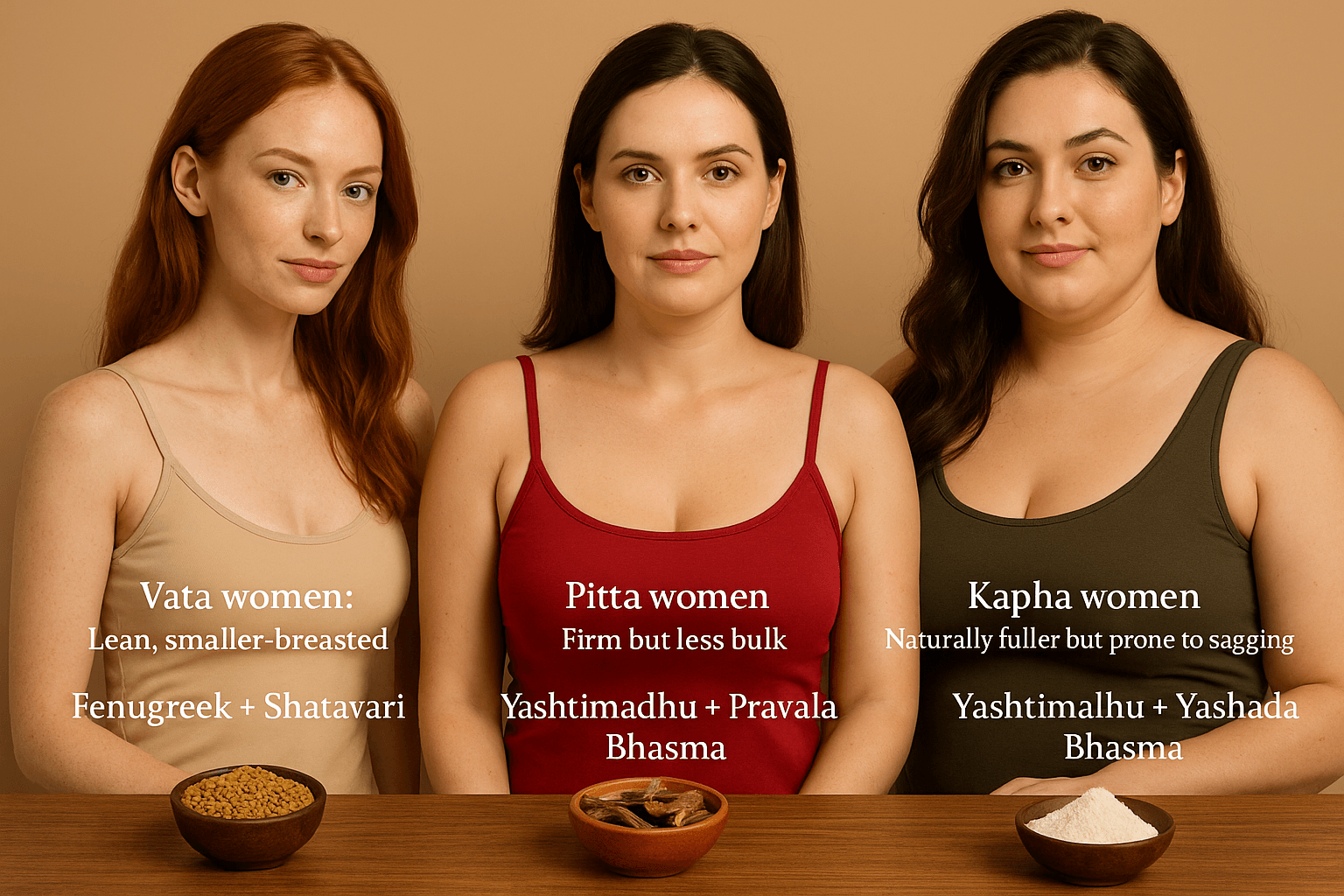
Ayurveda recognizes that no two women are alike. Each person’s natural constitution (Prakriti) determines how her body responds to nourishment, hormones, and rejuvenation therapies.
This is why a one-size-fits-all approach fails — and where Ayurveda excels through its tailored Rasayana therapy.
Vata Prakriti – Nourish and Build
Women with dominant Vata Dosha often have a slender frame, smaller breasts, and faster metabolism. Their tissues dry out easily, leading to undernourishment and reduced hormonal flow.
Best Herbs and Rasayanas
- Fenugreek (Methi): Builds Mamsa Dhatu (muscle tissue) and improves nutrient absorption.
- Shatavari: Enhances Rasa Dhatu and Stanya Dhatu for fuller, hydrated tissue development.
- Supportive Anupana: Warm milk with ghee to balance dryness and improve absorption.
Ideal Combination: Fenugreek + Shatavari Avaleha with a diet rich in ghee, sesame oil, and dates [44][46].
Pitta Prakriti – Calm and Balance
Women with Pitta dominance usually have firm breasts with less volume and are prone to hormonal fluctuations and heat sensitivity. Their strong metabolism can deplete tissue nourishment.
Best Herbs and Rasayanas
- Yashtimadhu (Licorice Root): Cooling and stabilizing; balances Pitta while supporting firmness.
- Pravala Bhasma (Coral Calcium): Natural coolant and mineral tonic that restores fluid balance.
- Supportive Anupana: Milk infused with rose petals or sandalwood for emotional calm.
Ideal Combination: Yashtimadhu + Pravala Bhasma with gentle Rasayanas such as Amalaki or Shatavari Kalpa [19][23][57].
Kapha Prakriti – Tone and Firm
Women of Kapha constitution often have naturally fuller breasts, softer tissues, and slower metabolism. While the natural volume is an advantage, they may experience sagging or water retention when Agni is low.
Best Herbs and Rasayanas
- Yashtimadhu: Promotes tone and prevents flaccidity.
- Yashada Bhasma (Zinc Calx): Strengthens connective tissue and improves skin firmness.
- Supportive Anupana: Honey or Trikatu Churna to kindle Agni and enhance metabolism.
Ideal Combination: Yashtimadhu + Yashada Bhasma with a light diet, daily Abhyanga (oil massage), and gentle yoga [19][32][58].
Why This Matters
Most modern beauty blogs and supplements overlook that Ayurvedic formulations must adapt to each woman’s Prakriti.
What nourishes one woman may create imbalance in another. This is exactly why the same market product may work beautifully for some but fail for others — because it was never personalized to the user’s Dosha and Dhatu balance.
Ayurveda’s individualized method aligns herbs, minerals, diet, and lifestyle with each woman’s internal chemistry. The result is balanced hormones, stable tissue development, and sustainable transformation — naturally and safely.
⚕️ Educational Highlight: Why Generic Products Fail

Most commercial breast-enhancement creams, pills, or oils are created with a fixed formula designed for mass appeal.
Ayurveda teaches that the body’s response depends on its Prakriti — Vata, Pitta, or Kapha.
When a Vata woman uses a Kapha-oriented formula, she may experience dryness or no result at all.
Likewise, a Kapha woman using a heavy, nourishing tonic might face swelling or sluggishness.
That’s why Ayurvedic doctors first determine your Prakriti, then prescribe customized Avalehas and Bhasma-based Rasayanas suited to your constitution.
Personalization ensures that results are real, safe, and lasting — not random or inconsistent.
Holistic Benefits Beyond Enlargement
Ayurveda teaches that beauty and vitality arise from inner balance, not external alteration.
The herbs used for breast enhancement — Shatavari, Yashtimadhu, and Fenugreek — extend far beyond cosmetic change. They rejuvenate the body’s internal systems, bringing harmony between hormones, emotions, and cellular energy.
Unlike temporary hormone-based creams or surgical implants, these Rasayanas create transformation from within, nurturing the subtle Dhatus (tissues) that define both health and confidence.
1. Improved Fertility through Shukra Dhatu Nourishment
When the reproductive essence (Shukra Dhatu) is weak, it affects hormonal balance, libido, and emotional steadiness.
These herbs — especially Shatavari and Yashtimadhu — restore Shukra Dhatu, improving fertility and reproductive vigor while stabilizing menstrual rhythms [5][20].
This balanced fertility energy radiates outward, expressed as glow, vitality, and feminine confidence.
2. Balanced Menstrual Cycles
Irregular or painful menstruation often stems from disturbed Vata or Pitta Dosha and depletion of Rasa Dhatu.
By cooling Pitta and nourishing Rasa, Yashtimadhu and Shatavari regulate hormonal cycles naturally, without synthetic interventions [18][21].
They promote smooth ovulation, stable emotions, and predictable cycles — key signs of inner hormonal balance.
3. Enhanced Lactation and Postpartum Recovery
In classical texts, both Shatavari and Fenugreek are described as Stanyajanana dravyas — agents that improve milk production and breast tissue health.
Their phytoestrogenic action gently stimulates mammary glands, enhancing both quantity and quality of breast milk [36][47].
This not only supports healthy motherhood but also aids in faster tissue repair after childbirth.
4. Building Ojas for Skin Glow and Emotional Stability
Ojas — the essence of all seven Dhatus — represents immunity, radiance, and resilience.
When Ojas is strong, the skin glows, the mind feels calm, and the heart projects confidence.
These herbs act as Ojas-enhancing Rasayanas, improving nutrient absorption, hormonal steadiness, and emotional balance [21][46].
This is why women who follow Ayurvedic therapy often notice not only physical development but also a brighter complexion and increased self-assurance.
5. Reducing Body Image Anxiety Naturally
Modern society often equates self-worth with appearance, causing deep psychological distress.
Ayurveda, however, views beauty as Swasthya Lakshana — a sign of internal harmony.
When hormones stabilize, digestion improves, and Ojas flows freely, body confidence returns organically.
By addressing emotional and biochemical roots together, these Rasayanas reduce body image anxiety and help women feel comfortable in their natural form [32][48].
The Deeper Truth
True beauty is not manufactured — it is awakened.
When tissues are nourished, Doshas are balanced, and Ojas is strengthened, the body expresses harmony as radiant curves, healthy cycles, calm emotions, and glowing skin.
This is the essence of Ayurveda’s holistic approach to feminine wellness — restoring not just form, but also joy, grace, and inner balance.
Frequently Asked Questions (FAQs)
1. Can Ayurveda really increase breast size naturally?
Yes. Ayurveda focuses on nourishing the Rasa Dhatu (plasma tissue) and Stanya Dhatu (breast tissue) through Rasayana herbs such as Shatavari, Yashtimadhu, and Fenugreek.
These herbs improve hormone balance, tissue regeneration, and circulation — leading to gradual, natural enlargement without side effects or hormonal drugs.
2. How long does it take to see results with Ayurvedic treatment?
Visible changes typically appear within 2-3 weeks when used under professional supervision with the correct diet, lifestyle, and Anupana (supportive medium such as ghee or milk).
However, complete development depends on individual Prakriti, hormone status, and consistency of use. Unlike synthetic options, results achieved through Ayurveda are stable and long-lasting.
3. Is breast enlargement with herbs safe?
Yes, when done correctly. Ayurvedic herbs are natural Rasayanas that restore hormonal harmony and tissue vitality.
However, unverified powders or over-the-counter “herbal pills” can be unsafe. Always use GMP-certified formulations prepared under Ayurvedic doctor supervision to ensure purity and correct dosage.
4. Can these herbs cause hormonal side effects or weight gain?
No. Unlike synthetic estrogens, Ayurvedic phytoestrogens adapt to the body’s needs.
They support hormone regulation rather than forcing hormonal change. Properly balanced Rasayana therapy does not cause unwanted weight gain; instead, it improves metabolism and tissue tone.
5. Can I take these herbs if I’m planning pregnancy or breastfeeding?
Yes, but only under supervision. Herbs like Shatavari and Fenugreek are traditionally used to enhance fertility and promote healthy lactation.
Dosages and combinations must be customized by your Ayurvedic doctor, as requirements differ during pregnancy and postpartum phases.
6. Why do market creams and capsules work for some but not for others?
Because they are generic formulas. Ayurveda emphasizes personalization — what works for one Prakriti type (body constitution) may not suit another.
That’s why customized Rasayana therapy, adjusted for Vata, Pitta, or Kapha dominance, delivers consistent and lasting results, while commercial products often fail to do so.
7. Are Bhasmas (like Suvarna, Abhrak, Mukta Shukti) necessary for best results?
They’re not mandatory but are highly beneficial. When used in micro-quantities, these purified mineral preparations amplify the rejuvenative and hormonal effects of herbs.
For instance, Suvarna Bhasma supports endocrine function, Abhrak Bhasma boosts metabolism, and Mukta Shukti Bhasma provides firmness and glow.
These must only be taken under certified Ayurvedic supervision.
8. What diet supports natural breast enlargement in Ayurveda?
A nourishing diet is essential. Include:
- Warm milk with ghee or dates.
- Almonds, sesame seeds, figs, and jaggery.
- Moong dal, lentils, and root vegetables.
Avoid cold, dry, and spicy foods, excessive caffeine, and stress — all of which deplete Rasa Dhatu and affect hormonal balance.
9. Can exercise help along with Ayurvedic herbs?
Yes. Gentle chest-opening yoga poses like Bhujangasana (Cobra Pose), Dhanurasana (Bow Pose), and Matsyasana (Fish Pose) help strengthen underlying muscles and improve circulation.
However, Ayurveda emphasizes moderation — overexertion or excessive cardio can aggravate Vata Dosha and hinder tissue nourishment.
10. Can men use these herbs?
Yes, but in modified form. Herbs like Shatavari and Yashtimadhu can be used in small doses for hormonal balance, stamina, and vitality.
However, they are not meant for feminizing effects unless prescribed for specific endocrine or metabolic disorders.
11. Will results last after stopping the herbs?
Yes. Once tissue nourishment and hormonal equilibrium are achieved, the results are stable.
Ayurveda works by correcting root imbalances rather than producing temporary swelling, so the benefits persist even after discontinuation — provided diet and lifestyle remain balanced.
12. What makes Ayurvedic treatment different from modern methods?
Modern methods (like hormonal pills or implants) alter the body externally and can lead to side effects.
Ayurveda works internally — balancing Doshas, strengthening Dhatus, and improving Ojas — leading to natural, graceful, and lasting enhancement.
It transforms not just the body but also confidence, vitality, and emotional well-being.
References
Shatavari (and general Ayurvedic foundations)
- Bhāvamiśra. (2010). Bhāvaprakāśa of Bhāvamiśra (Vol. 2, Madhyama Khaṇḍa 38/47). (K. R. Srikantha Murthy, Trans.). Varanasi: Chaukhambha Orientalia. (Print book)
- Agniveśa. (2006). Charaka Saṃhitā: Text with English Translation & Critical Exposition (B. Dash & R. K. Sharma, Trans.). Varanasi: Chaukhambha Sanskrit Series Office. (Print book)
- Sharma, P. V. (1994). Dravyaguṇa Vijñāna (Materia Medica), Vol. 2. Varanasi: Chaukhambha Bharati Academy. (Print book)
- Alok, S., Jain, S. K., Verma, A., Kumar, M., Mahor, A., & Sabharwal, M. (2013). Plant profile, phytochemistry and pharmacology of Asparagus racemosus (Shatavari): A review. Asian Pacific Journal of Tropical Disease, 3(3), 242–251. https://doi.org/10.1016/S2222-1808(13)60049-3
- Sharma, S., Gupta, P., & Prasad, S. (2018). Phytoestrogenic activity of Asparagus racemosus and its role in women’s health. Journal of Ethnopharmacology, 214, 302–310. https://doi.org/10.1016/j.jep.2017.12.015
- Pandey, A., & Singh, P. (2017). Adaptogenic and hormonal properties of Asparagus racemosus. Phytotherapy Research, 31(10), 1509–1520. https://doi.org/10.1002/ptr.5881
- Sharma, P., & Bhatnagar, S. (2011). Efficacy of Asparagus racemosus (Shatavari) in increasing breast milk production in lactating mothers: A randomized controlled trial. International Journal of Ayurveda Research, 2(4), 201–205. https://doi.org/10.4103/0974-7788.91163
- Tiwari, P., Nayak, P., & Das, S. (2015). Shatavari and female reproductive health: A clinical overview. Journal of Ayurveda and Integrative Medicine, 6(1), 33–39. https://doi.org/10.4103/0975-9476.146556
- Himalaya Wellness. (2023). Evecare – Women’s wellness formula (product page). https://himalayawellness.in
- Dabur India Ltd. (2023). Dabur Shatavari Tablets (product page). https://www.dabur.com
- Nature’s Way. (2023). Shatavari – Women’s health supplement (product page). https://www.naturesway.com
- Organic India. (2023). Shatavari (product page). https://www.organicindia.com
- Govind Das. (2022). Bhaiṣajya Ratnāvalī (Rasāyana Prakaraṇa). Varanasi: Chaukhambha Sanskrit Saṅsthan. (Print book)
- World Health Organization. (2021). WHO monographs on selected medicinal plants – Vol. 6: Asparagus racemosus. (Monograph series; library/publisher access)
Yashtimadhu / Licorice (Glycyrrhiza glabra)
- Bhāvaprakāśa Nighaṇṭu (Harītakyādi Varga; verses on Yaṣṭimadhu). Varanasi: Chaukhambha Sanskrit Saṅsthan. (Classical lexicon; print)
- Hebbar, J. V. (2012, Dec 8). Licorice (Yashtimadhu) – Ayurvedic properties and uses. EasyAyurveda. https://www.easyayurveda.com/2012/12/08/licorice-benefits-medicinal-qualities-complete-ayurveda-details/
- Pastorino, G., Cornara, L., Soares, S., Rodrigues, F., & Oliveira, M. B. P. P. (2018). Liquorice (Glycyrrhiza glabra): A phytochemical and pharmacological review. Phytotherapy Research, 32(12), 2323–2339. https://doi.org/10.1002/ptr.6178
- Tamir, S., Eizenberg, M., Somjen, D., et al. (2001). Estrogen-like activity of glabrene and other constituents isolated from licorice root. Phytochemistry, 58(3), 373–383. https://doi.org/10.1016/S0031-9422(01)00249-9
- Hu, C., Yuan, Y., et al. (2009). Estrogenic activities of licorice extracts and their active fractions. Reproductive Biology and Endocrinology, 7, 12. https://doi.org/10.1186/1477-7827-7-12
- Yokota, T., Nishio, H., Kubota, Y., & Mizoguchi, M. (1998). The inhibitory effect of glabridin from licorice extracts on melanogenesis and inflammation. Pigment Cell Research, 11(6), 355–361. https://doi.org/10.1111/j.1600-0749.1998.tb00491.x
- Cerulli, A., Masullo, M., Montoro, P., & Pizza, C. (2022). Licorice in cosmetics: Depigmentation and photoaging prevention. Cosmetics, 9(1), 7. https://doi.org/10.3390/cosmetics9010007
- Shiseido. (2023). Ingredient listings featuring Glycyrrhiza glabra (Licorice) root extract (INCI). https://www.shiseido.com
- Biotique. (2023). Bio Breast Firming Cream (product page). https://www.biotique.com
- Himalaya Wellness. (2023). Evecare (product page). https://himalayawellness.in
- NOW Foods. (2023). Licorice Root capsules (product page). https://www.nowfoods.com
- Isbrucker, R., & Burdock, G. A. (2006). Risk and safety assessment(†) of licorice root (Glycyrrhiza spp.). Regulatory Toxicology and Pharmacology, 46(3), 167–192. https://doi.org/10.1016/j.yrtph.2006.06.002
- World Health Organization. (2021). WHO monographs on selected medicinal plants – Vol. 6: Glycyrrhiza glabra. (Monograph series; library/publisher access)
Fenugreek (Trigonella foenum-graecum)
- Sharma, P. V. (2010). Nighaṇṭu Ratnākara (Vol. 1). Varanasi: Chaukhambha Bharati Academy. (Print book; Stanyajanana classification)
- Sauvaire, Y., Ribes, G., Baccou, J. C., & Loubatières-Mariani, M. M. (1998). Steroidal sapogenins and saponins of fenugreek seeds. Phytochemistry, 44(4), 897–903. https://doi.org/10.1016/S0031-9422(96)00633-4
- Basch, E., Ulbricht, C., Kuo, G., Szapary, P., & Smith, M. (2003). Therapeutic applications of fenugreek. Alternative Medicine Review, 8(1), 20–27. (PMID: 12611558) https://pubmed.ncbi.nlm.nih.gov/12611558/
- Turkyılmaz, C., Onal, E., Hirfanoglu, I. M., et al. (2011). The effect of Trigonella foenum-graecum (fenugreek) on breast milk production: A randomized, double-blind trial. Breastfeeding Medicine, 6(3), 137–142. https://doi.org/10.1089/bfm.2010.0006
- Steels, E., Rao, A., & Vitetta, L. (2017). Physiological aspects of female sexual function and the role of fenugreek extract. Phytotherapy Research, 31(11), 1692–1700. https://doi.org/10.1002/ptr.5894
- Abdelgadir, E. H., Ahmed, R. H., Hamid, O., & Ahmed, T. (2013). Antihyperlipidemic and antioxidant activities of fenugreek seed extract. Journal of Ethnopharmacology, 148(2), 515–524. https://doi.org/10.1016/j.jep.2013.04.006
- World Health Organization. (2021). WHO monographs on selected medicinal plants – Vol. 6: Trigonella foenum-graecum (Fenugreek). (Monograph series; library/publisher access)
- Avon. (2023). Naturals Bust Firming Lotion (product page). https://www.avon.com
- The Body Shop. (2023). Roots of Strength™ Firming Serum (product page). https://www.thebodyshop.com
- Himalaya Wellness. (2023). Menosan (product page). https://himalayawellness.in
- Nature’s Way. (2023). Fenugreek Seed Extract (product page). https://www.naturesway.com
- Danone India. (2023). Mother’s Horlicks (product page). https://www.horlicks.in
Synergy, Rasāyana bhasmas, and personalization concepts
- Govind Das. (2022). Bhaiṣajya Ratnāvalī (Rasāyana Prakaraṇa; Stanya–Sphika Vardhani Rasāyana). Varanasi: Chaukhambha Sanskrit Saṅsthan. (Print book)
- Ayurvedic Pharmacopoeia Committee. (2008–2016). Ayurvedic Pharmacopoeia of India (multiple vols.). Govt. of India. (For bhasma standards; print/official portal)
- Dwarakanath, C. (2009). Introduction to Rasashastra. Chaukhambha Orientalia. (Bhasma overview; print)
- Prayoga-saṅgraha / Rasa-tarangini (standard Rasashastra texts on Suvarna, Abhraka, Mukta-śukti bhasmas). (Classical texts; print)
- Singh, N., & Mishra, S. (2018). Concept of Ojas and Rasāyana in Ayurveda. Ancient Science of Life, 37(3), 153–159. https://doi.org/10.4103/asl.ASL_180_17
- Sharma, S., & Gupta, P. (2019). Concept of Agni and Dhātu Poṣaṇa (tissue nourishment) in Ayurveda. Ancient Science of Life, 38(4), 202–210. https://doi.org/10.4103/asl.ASL_68_19
- Srikantha Murthy, K. R. (2010). Suśruta Saṃhitā (Vols. 1–3). Varanasi: Chaukhambha Orientalia. (Print book; Dhātu/tissue concepts)
- Dash, B., & Sharma, R. K. (2006). Charaka Saṃhitā (Digestive fire/Agni & Rasāyana doctrines). Varanasi: Chaukhambha Sanskrit Series. (Print book)
- WHO. (2004). WHO guidelines on safety monitoring of herbal medicines in pharmacovigilance systems. https://apps.who.int/iris/handle/10665/43034








